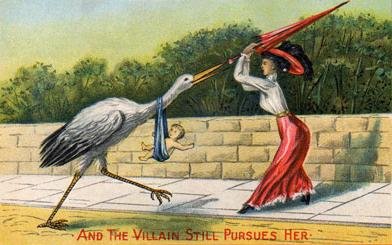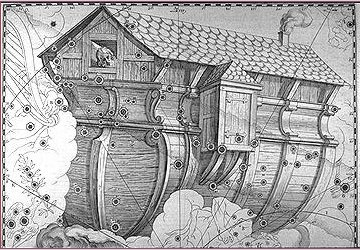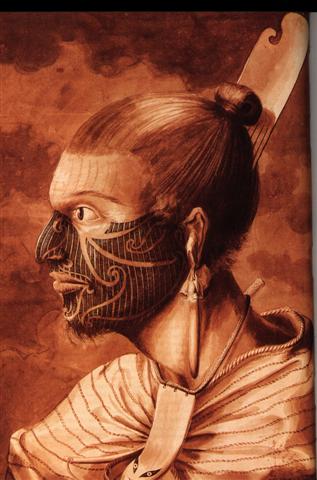In order to go across the Waters of the Night (Egyptian: Nut) a Ship was necessary:
And therefore a new one (ship, house, etc) had to be constructed for every cycle. ... The spectators greatly admired Hiro's ship and raised deafening shouts. Then the canoe was made to drink salt water; it was dipped forwards and backwards in the waves of the great moving altar of the gods and thus consecrated to Tane. A marae was made for him in the little house aft of the deck, and the three masts were rigged with ropes and strong mats for sails and long tapa pennants streaming from them ... ... (It) was made proper [→ Propper, Toko-te-rangi], the Raised-up-Sky-Place, the Eight-House-Partitions, (is) its holy name, 'the house of the north'. In this way we learn that First Father's 'entering the sky' also created a house in the north and that it was made of eight partitions. The name of that house, 'Raised-up-Sky', is the reciprocal opposite of the 'Lying-down-Sky' of the 4 Ahaw 8 Kumk'u place ...
... Väinämöinen set about building a boat, but when it came to the prow and the stern, he found he needed three words in his rune that he did not know, however he sought for them. In vain he looked on the heads of the swallows, on the necks of the swans, on the backs of the geese, under the tongues of the reindeer. He found a number of words, but not those he needed. Then he thought of seeking them in the realm of Death, Tuonela, but in vain. He escaped back to the world of the living only thanks to his potent magic. He was still missing his three runes. He was then told by a shepherd to search in the mouth of Antero Vipunen, the giant ogre. The road, he was told, went over swords and sharpened axes. Ilmarinen made shoes, shirt and gloves of iron for him, but warned him that he would find the great Vipunen dead. Nevertheless, the hero went. The giant lay underground, and trees grew over his head. Väinämöinen found his way to the giant's mouth, and planted his iron staff in it. The giant awoke and suddenly opened his huge mouth. Väinämöinen slipped into it and was swallowed. As soon as he reached the enormous stomach, he thought of getting out. He built himself a raft and floated on it up and down inside the giant. The giant felt tickled and told him in many and no uncertain words where he might go, but he did not yield any runes. Then Väinämöinen built a smithy and began to hammer his iron on an anvil, torturing the entrails of Vipunen, who howled out magic songs to curse him away. But Väinämöinen said, thank you, he was very comfortable and would not go unless he got the secret words. Then Vipunen at last unlocked the treasure of his powerful runes. Many days and nights he sang, and the sun and the moon and the waves of the sea and the waterfalls stood still to hear him. Väinämöinen treasured them all and finally agreed to come out. Vipunen opened his great jaws, and the hero issued forth to go and build his boat at last ... ... Balancing the notion of tapu, though not in perfect dichotomy, is the notion of noa. This pertains to mundane, ordinary objects and functions - household and serving utensils, the acts of preparing and eating food, the many small and common interactions of everyday life. Noa is safe - without preternatural sanction or restricted association, it is demonstrated by the lifting of the condition of tapu from a particular environment or object. A newly built house, ornamented and fresh, would be considered tapu - unsafe, prohibited, raw with spirit and inaccessible to the common touch of people. Making the place noa - 'blessing' it in current terms - would involve ritual, and the crossing of the threshold, usually by a high-born woman. Her special form of tapu would counter the energies within the house, and thus render it noa, and safe for general entry. Such ritual continues to be observed today; even in the context of an ethnological or fine arts exhibition, these procedures are followed, to appease the ancestral forces who may generate tapu, which imbues the objects with dread or beauty ... ... On February 9 the Chorti Ah K'in, 'diviners', begin the agricultural year. Both the 260-day cycle and the solar year are used in setting dates for religious and agricultural ceremonies, especially when those rituals fall at the same time in both calendars. The ceremony begins when the diviners go to a sacred spring where they choose five stones with the proper shape and color. These stones will mark the five positions of the sacred cosmogram created by the ritual. When the stones are brought back to the ceremonial house, two diviners start the ritual by placing the stones on a table in a careful pattern that reproduces the schematic of the universe. At the same time, helpers under the table replace last year's diagram with the new one. They believe that by placing the cosmic diagram under the base of God at the center of the world they demonstrate that God dominates the universe. The priests place the stones in a very particular order. First the stone that corresponds to the sun in the eastern, sunrise position of summer solstice is set down; then the stone corresponding to the western, sunset position of the same solstice. This is followed by stones representing the western, sunset position of the winter solstice, then its eastern, sunrise position. Together these four stones form a square. They sit at the four corners of the square just as we saw in the Creation story from the Classic period and in the Popol Vuh. Finally, the center stone is placed to form the ancient five-point sign modern researchers called the quincunx ... ... Sun (and the moon and the other 'planets' too) move against the background of the stars which were fixed on the 'roof' of the sky (the firmanent). The locations changed over the cycle of movement and it was customary to name the locations and to call them 'houses' (or 'mansions'). For instance was Leo considered to be the House of the Sun: The Egyptian king Necepsos, and his philosopher Petosiris, taught that at the Creation the sun rose here [in Leo] near Denebola; and hence Leo was Domicilium Solis, the emblem of fire and heat, and, in astrology, the House of the Sun, governing the human heart ... ... The modern English word can be traced back to Proto-Germanic *sturkaz. Nearly every Germanic language has a descendant of this proto-language word to indicate the (White) stork ... the Germanic root is probably related to the modern English 'stark', in reference to the stiff or rigid posture of a European species, the White Stork. A non-Germanic word linked to it may be Greek torgos ('vulture'). In some West Germanic languages cognate words of a different etymology exist. They originate from *uda-faro, uda being related to water meaning something like swamp or moist area and faro being related to fare, so *uda-faro being he who walks in the swamp. In later times this name was reanalyzed as *ōdaboro, ōda 'fortune, wealth' + boro 'bearer' meaning he who brings wealth adding to the myth of storks as maintainers of welfare and bringing the children ... In Victorian times the details of human reproduction were difficult to approach, especially in reply to a younger child's query of 'Where did I come from?'; 'The stork brought you to us' was the tactic used to avoid discussion of sex. This habit was derived from the once popular superstition that storks were the harbingers of happiness and prosperity, and possibly from the habit of some storks of nesting atop chimneys, down which the new baby could be imagined as entering the house ...
... The swinging doors theme, which is found all the world over, belongs most certainly to the oldest mythic tradition known to man. The same is probably true of the swing, around which the American Indians built up a whole mythology ...; swings existed in real life, particularly among the Salish, whose various dialects distinguished between the cradle-swing - 'suspended from a long thin pole stuck in the ground and the upper end bent over ... the weight of the child being sufficient ... to allow the cradle to swing gently up and down with the movements of the child, which were kept up by a cord attached to the cradle and given to the mother or one of the old women of the household to pull from time to time' ... and the seat swing, which at least among certain groups had a ceremonial or ritual use, reserved, it would seem, for adult women ... In the G text there are 123 glyphs (runes) which taken together measured out a length corresponding to ⅓ of the cycle of the Sun year.
The Rei ship at Ga2-27 (→ 22 / 7 = π) is glyph number 57 (or 58 if counted from day zero on side a of the G tablet) and Ga7-10 is number 179 (or 180). Presumably we should understand this interval as a kind of measure for Argo Navis - the Ship of Noa.
Naos in Argo Navis rose with the Sun at 9h and 7h later, at Ga7-10, came 16h (→ grass, te mauku tokoa). 7h / 24h * 365.25 = 107 right ascension days = 1½ * 314 - 364. Or better: 7h / 24h * 403 = 118 (= 472 / 4). The number of glyphs, including the empty zero place, on the G tablet was designed to be 1 + 471 (= 1½ * 314) = 8 * 59. Canopus was at Ga2-1 (day 32 if counted from day zero), and 180 (Ga7-10) - Ga2-1 (32) = 148. The Sunken Ship (Argo Navis) ... Snorri Sterluson explains why 'Frodi's grist' is a kenning for gold. Frodi ruled during a peaceful and productive period, contemporaneous with Augustus's Pax Romana and the birth of Christ; hence the kenning. There were neither thieves nor robbers during this period, 'so that a gold ring lay long on Jalang's heath'. Snorri continues his account with the legend of the mill beyond what is told in the song: The girls' grinding produced an army hostile to Frodi. On the very day of the girls' predictions, the sea-king, Musing (Son of the Mouse), landed on the Danish shore, killed Frodi, and took away Grotti and the women on his ship. The girls were bidden to grind out salt on the mill. At midnight they asked for further instructions. 'Keep grinding', he told them. Then they ground with such vigor that the ship sank. Water poured into the eye of the mill, creating the maelstroem of the sea. Therefore the sea was salt. Incidentally, the mill was given a kenning, Serpent's Couch ... was not intact because it had lost its prow (which we can see also in the Egyptian illustration of Nut above). 172 (midsummer) - 149 = 23 (= *64 - *41):
... This is probably associable with the general Polynesian rei, which means the tooth of the cachalot, an object held in such esteem that in Viti one tooth (tambua) was the ransom of a man's life, the ransom of a soul on the spirit path that led through the perils of Na Kauvandra to the last abode in Mbulotu ....
|
||||||||||||||||||||||||||||||||||||||||||||||||||||||||||||||||||||||||||||||||||||||||||||||||||||||||||||||||||||||||||||||||||||||||||||||||||||||







 1
winter solstice
1
winter solstice
















.jpg)
.jpg)
